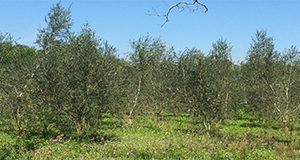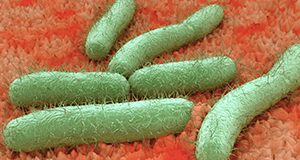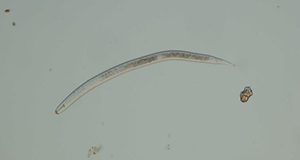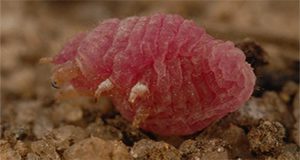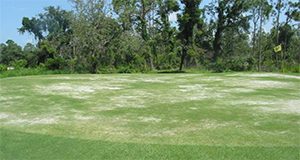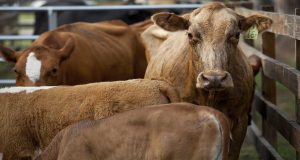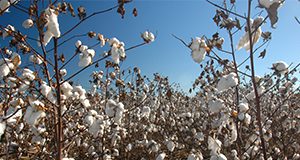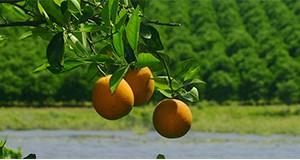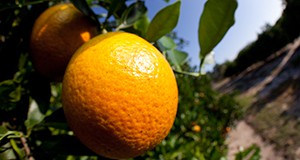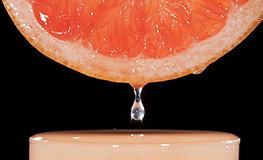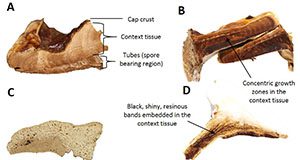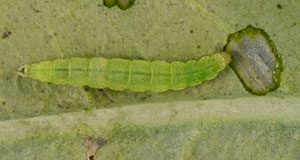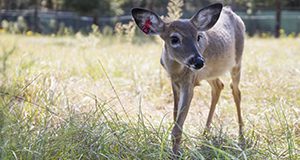This 8-page fact sheet written by Zane J. Grabau and Christopher Vann and published by the Department of Entomology and Nematology explains how corn producers can spot nematode symptoms, sample for nematodes, and manage nematode problems.
http://edis.ifas.ufl.edu/ng014
Category: Agriculture
Xylella fastidiosa and Olive Quick Decline: Symptoms and Identification of an Insect Vectored Pathogen
A plant disease called Olive Quick Decline is killing olive trees throughout southern Italy. Although the pathogen that causes the disease is not known in Florida, it may spread to the state, which means that olive producers and homeowners with olives must watch for symptoms of the disease as well as for the leafhopper insects that spread it. This 3-page fact sheet written by Whitney Elmore and Jennifer L. Gillett-Kaufman and published by the Department of Entomology and Nematology explains how to monitor for the disease and its insect vectors and offers advice and assistance for commercial and hobby olive growers.
http://edis.ifas.ufl.edu/in1165
Preventing Foodborne Illness: E. coli O157:H7
This seven-page fact sheet discusses the common foodborne pathogen E. coli O157:H7, especially as it concerns food handlers, processors and retailers. Written by Keith R. Schneider, Renée Goodrich Schneider, Ploy Kurdmongkoltham, and Bruna Bertoldi and published by the Food Science and Human Nutrition Department.
http://edis.ifas.ufl.edu/fs097
Management of Plant-Parasitic Nematodes in Florida Cotton Production
This 8-page fact sheet written by Zane J. Grabau and published in January 2017 by the UF Department of Entomology and Nematology explains how to diagnose and manage nematode problems in cotton production.
http://edis.ifas.ufl.edu/ng015
Management of Plant-Parasitic Nematodes in Florida Soybean Production
This 8-page fact sheet written by Zane J. Grabau and published by the UF Department of Entomology and Nematology in January 2017 explains how to identify and manage a nematode issue in a soybean operation.
http://edis.ifas.ufl.edu/ng018
Managing Scale Insects and Mealybugs on Turfgrass
This 8-page fact sheet written by Adam Dale and published by the UF Department of Entomology and Nematology in February 2017 describes the types of scale insects and mealybugs that can become pests in turf, explains the damage they do, and lists management techniques to control them.
http://edis.ifas.ufl.edu/in1166
Nematode Management for Golf Courses in Florida
UF/IFAS is committed to providing the most current information on the notoriously difficult problem of managing nematodes on golf courses. This publication is updated and revised whenever there is a breaking development, to bring you the new information and management advice. Nine pages, revised in January 2017 by William T. Crow and published by the UF Department of Entomology and Nematology.
http://edis.ifas.ufl.edu/in124
Rumen Protozoa: The Animals within the Cow
As a cow ambles around and eats from the feed bunk, legions of other “animals” are feeding within the cow’s rumen. Billions of protozoa swim about in a single, 20-gallon rumen, colliding with one another while engulfing feed particles and bacteria. These microbes contribute vitally to rumen fermentation and have both positive and negative impacts on animal performance. This 4-page fact sheet discusses classification, activities, removal, and impacts of protozoa. Written by Timothy J. Hackmann, and published by the UF Department of Animal Sciences, January 2017.
http://edis.ifas.ufl.edu/an331
Helpful Details for Commercial Propagation of Woody Plant Stem Cuttings
This three-page fact sheet provides details that are very important for successful propagation of woody plant stem cuttings, such as sanitation, quality of cuttings, the time of year/day to take cuttings, stem size diameter and length of cutting, location of cuts/terminal bud removal, and environmental conditions. Written by Thomas Yeager and published by the Environmental Horticulture Department.
http://edis.ifas.ufl.edu/ep536
Evolution of Citrus Disease Management Programs and Their Economic Implications: The Case of Florida’s Citrus Industry
New exotic diseases (citrus canker, HLB, and citrus black spot) have sharply increased the real cost of production of citrus in Florida. Growers have been applying different management strategies, and more effective treatments are being researched. The costs and benefits of these alternatives will need to be quantified to establish their economic feasibility. This 5-page fact sheet written by Ariel Singerman and Marina Burani-Arouca and published by the Food and Resource Economics Department focuses on the costs of managing exotic citrus diseases as they become endemic or established within a citrus industry, with Florida used as an example. The steep increase in the real cost of production of citrus in Florida from 2003/04 to 2014/15 provides evidence that managing endemic exotic diseases is very costly for growers, even without taking into account the effect those diseases have on yields. Therefore, governmental policies focused on preventing the introduction of additional exotic diseases would be highly beneficial for citrus growers and the Florida citrus industry as a whole.
edis.ifas.ufl.edu/fe915
Using Dicamba in Dicamba-Tolerant Crops
After many years in development, dicamba will likely be fully approved for use in tolerant cotton varieties for the 2017 growing season. There is great concern that dicamba drift can result in significant losses in nearby sensitive crops. This concern is well-founded because many crops (such as soybean, snap bean, and peanut) are highly sensitive to extremely low doses of dicamba. All precautions must be followed if these new dicamba formulations are to be used. This 3-page fact sheet discusses herbicide selection, discontinued use of ammonium sulfate, nozzle selection, boom height, and wind speed. It also addresses a few frequently asked questions. Written by J. Ferrell and R. Leon, and published by the UF Agronomy Department, February 2017.
http://edis.ifas.ufl.edu/ag414
Cost of Production for Processed Oranges Grown in Southwest Florida, 2015/16
This 4-page fact sheet written by Ariel Singerman and published by the Department of Food and Resource Economics presents the cost of production per acre for processed oranges in southwest Florida during 2015/16. Thirteen growers participated in the survey and provided annual, per-acre costs by program for a “typical” irrigated, mature grove (10+ years old), including resets. The number of acres managed by their combined operations accounts for approximately 41,000 acres, of an estimated 257,298 acres devoted to oranges in the area, so the sample represents 16% of the acreage devoted to oranges in that region. Typical users of the estimates in this publication include growers, consultants, property appraisers, and researchers.
http://edis.ifas.ufl.edu/fe1007
Cost of Production for Processed Oranges Grown in Central Florida (Ridge), 2015/16
This 4-page fact sheet written by Ariel Singerman and published by the Department of Food and Resource Economics presents the cost of production per acre for processed oranges in central Florida during 2015/16. Five growers participated in the survey and provided annual, per-acre costs by program for a “typical” irrigated, mature grove (10+ years old), including resets. The number of acres managed by their combined operations accounts for approximately 29,000 acres, of an estimated 137,154 acres devoted to oranges in the area, so the sample represents 21% of the acreage devoted to oranges in that region. Typical users of the estimates in this publication include growers, consultants, property appraisers, and researchers.
http://edis.ifas.ufl.edu/fe1006
An Overview of the Grapefruit Market in South Korea
According to the Foreign Agricultural Service of the United States Department of Agriculture, worldwide consumption of fresh grapefruit in 2014/15 increased from 4.2 million to 5.2 million metric tons. China, which is the largest producer of grapefruit, was largely responsible for the increase. In South Korea, however, the state of Florida in the United States has traditionally dominated the grapefruit market. The South Korean grapefruit market has been increasing in recent years and is expected to keep growing. The industry in Florida now faces fierce competition from other suppliers with lower import prices and different harvest seasons. This 5-page fact sheet written by Yan Heng, Hyeyoung Kim, and Lisa House and published by the Food and Resource Economics Department aims to provide an overview of the grapefruit market in South Korea and evaluate the potential of this market for Florida fresh grapefruit producers.
http://edis.ifas.ufl.edu/fe1003
The Laccate Ganoderma of the Southeastern United States: A Cosmopolitan and Important Genus of Wood Decay Fungi
Ganoderma Karst. is a large and diverse genus of wood decay fungi that can rot the roots and/or lower trunk of many tree species. There are several laccate (varnished or polished) Ganoderma species that are found in the southeastern United States and this six-page fact sheet provides an overview of the different species. Written by Andrew L. Loyd, Jason A. Smith, Brantlee S. Richter, Robert A. Blanchette, and Matthew E. Smith and published by the Plant Pathology Department.
http://edis.ifas.ufl.edu/pp333
Manejo de Insectos en Cruciferas (Cultivos de Coles) (Brocoli, Repollo, Coliflor, Col, Col Rizada, Mostaza, Rabano, Nabos)
Los vegetales conocidos como crucíferas son un grupo de cultivos amplio y cada vez más importante en Florida. Un número de insectos se alimenta exclusivamente de crucíferas y afecta todos los cultivos enlistados en el título.
This thirty-page fact sheet is the Spanish translation of IG150: Insect Management for Crucifers (Cole Crops). Written by S.E. Webb, A. Nino, y H.A. Smith and published by the Entomology and Nematology Department.
http://edis.ifas.ufl.edu/ig168
Fumigant and Non-Fumigant Nematicides Labeled for Agronomic Crops in Florida
Plant-parasitic nematodes can cause severe yield loss of agronomic crops in Florida. Chemical products for managing plant-parasitic nematodes are called nematicides. This three-page facts heet describes the nematicides registered for use in Florida. Written by Zane Grabau and published by the Department of Entomology and Nematology.
http://edis.ifas.ufl.edu/in1152
Biology and Management of Goosegrass (Eleusine indica (L.) Gaertn.) in Ornamental Plant Production
This six-page fact sheet provides information about the biology and management of goosegrass, including preemergence and postemergence control options. Written by Shawn Steed, Christopher Marble, Nathan S. Boyd, Andrew MacRae, and Kiran Fnu and published by the Environmental Horticulture Department.
http://edis.ifas.ufl.edu/ep538
Trueperella (Arcanobacterium pyogenes) in Farmed White-Tailed Deer
Trueperella is a harmless bacterium in intestinal tracts of ruminants like deer, cattle, and pigs, but if it migrates out of the intestine to other areas of an animal’s body and proliferates, it can make the animal sick. Trueperella causes many problems in deer, including lesions, abscesses, and pneumonia, and it is one of the types of bacteria that is known to contribute to the disease lumpy jaw. In young fawns, it is a common cause of death. This 3-page fact sheet written by Kathryn D. Pothier, Katherine A. Sayler, and Samantha M. Wisely and published by the Department of Wildlife Ecology and Conservation explains how to spot and treat trueperella, or, better yet, prevent it in the first place.
http://edis.ifas.ufl.edu/uw427
Insect and Mite Integrated Pest Management in Florida Cotton
Insect and mite pests of cotton feed on cotton roots, leaves, stems, and fruit and reduce plant health and productivity, and, subsequently, cotton crop yields. These pests hide in different places on or within the plant or field, which makes them difficult to find and identify and costly to manage. The purpose of this 14-page guide written by Joseph Funderburk, Nicole Casuso, Norman Leppla, and Michael Donahoe and published by the Department of Entomology and Nematology is to provide Florida cotton growers a selected set of options for integrated pest management of insects and mites in cotton fields. It serves as a reference for cultural, mechanical, biological, and chemical control of arthropods. The guide includes links to additional UF/IFAS EDIS articles, as well as external sources of information on arthropod management. The guide also contains a searchable table of registered insecticides, herbicides, and fungicides for Florida cotton.
edis.ifas.ufl.edu/in1111

